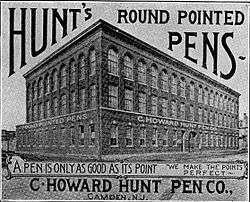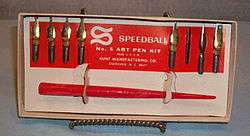C. Howard Hunt
|
| |
| Public | |
| Industry | Stationery |
| Fate | Defunct |
| Successor | Speedball |
| Founded | 1899 |
| Founder | C. Howard Hunt |
| Defunct | 1997 |
| Headquarters | Camden, New Jersey, U.S. |
Area served | United States |
Key people | George E. Bartol (President, 1903-17) [1] |
| Products | Dip pens |
C. Howard Hunt was an American company that manufactured dip pens, now commercialized under the brand Speedball.
History
The beginning


In 1899 C. Howard Hunt established a company in Camden, New Jersey. The C. Howard Hunt Pen Company invented the smooth gliding round pointed pen, which required about 15 operations in the manufacturing. Expert cutters used cutting presses to produce almost 45,000 pens a day from rolled sheets of steel. Workers imprinted, ground and shipped 25 pens per minute.[1]
Speedball pen
The Speedball pen was developed and patented by sign letterer Ross F. George of Seattle. His square-tipped pen could make broad and thin lines. George took the patent to the C. Howard Hunt Pen Company in 1915. They manufactured the pens in six sizes and published the Speedball Text Book, written by George. In 1925 the C. Howard Hunt Pen Company purchased the Boston Specialty Company, manufacturer of Boston Pencil Pointers.
In 1936, Hunt became America's first large manufacturer of inexpensive accessories for linoleum block printing, a popular school craft. Henry Frankenfield, printmaker and art educator, developed this line. [1]
Difficult times
Throughout the Great Depression, Hunt reduced operations, recovering with the development of the gold-plated stainless steel pen, which was boosted by the company's invention of a special patented tip. In 1942 regulations on stainless steel stopped production of pencil sharpeners and specialty metal items. The sale of silver alloy nibs kept the company viable during World War II.
Over the years, Hunt expanded its product line and markets through acquisitions such as Bienfang, Lit-Ning, Bevis and Data Products. Though some of these acquisitions are no longer part of the company, they do represent an important chapter in the Hunt story. [1]
George Bartol, III, joined the C. Howard Hunt Pen Company in 1946. He apprenticed in the company's manufacturing department, and succeeded his father as President in 1956. In 1969 he also became Chairman of the Board. Bartol's leadership transformed the small, family-owned C. Howard Hunt Pen Company into the publicly held Hunt Manufacturing Company. [1]
Restructuring
A new chapter to the history of Hunt began on November 14, 1997 when CEO Walt Glazer led a buyout of the Speedball division during the company restructuring. [2] Subsequently, Hunt pens are currently commercialized under the "Speedball" brand. [3]
Pens
Nibs manufactured by Howard C. Hunt, currently produced under the Speedball name:[4]
| Num. | Name | Point |
|---|---|---|
| 22 B | Extra Fine | Medium |
| 56 | School | Stiff |
| 99 | Drawing | Extra fine |
| 100 | Artist | Medium |
| 101 | Imperial | Extra fine |
| 102 | Crowquill | Very fine |
| 103 | Mapping | Very fine |
| 104 | Finest | Super fine |
| 107 | Hawk Quill | Super fine |
| 108 | Flexible Quill | Fine |
| 512 | Bowl Pointed | Fine |
| 513 EF | Globe | Extra fine |
Artists
Hunt pens have been widely used by a legion of comic book artists to ink their pages. Some of them are Walt Simonson, Dale Keown, Bob McLeod, Kevin Nowlan, Bill Sienkiewicz, Joe Sinnott and Andy Lanning (#102 pen users), George Pérez (#100) and Joe Rubinstein (#100, 103). [5]